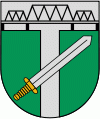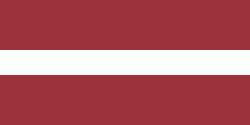Skrunda
 |
 |
The historical sources first mentioned Skrunda (Schrunden) in the Curonian Peninsula in 1253. In 1368 the Skrund Castle of the German Order was built on the left bank of Venta. During the Duchy of Courland and Semigallia period glass mills, powder mills, and nail, gun, and rifle workshops were operating in Skrunda. The finished products were transported down the Venta River. From 1685, through Skrunda, the main postal route of the Dukedom was Jelgava - Dobele - Blidene - Saldus - Skrunda - Grobina - Liepaja - Sventa - Momele. During the Swedish invasion of the Great Northern War, the town was plundered. At the beginning of the 19th century, near the ruins of the former Order Castle, the Skrunda Manor House was built in the classic style. It was restored in 1881.
The settlement began to form after the construction of the narrow-gauge railway line Liepaja- Aizpute, Aizputes-Skrunds- Saldus, during the First World War. During the struggle for freedom in Latvia, between 22 and 29 January 1919, at Skrunda a major battle took place between the 2nd Soviet Latvian Riflemen's Regiment and the Latvian Special Battalion, under the leadership of Oskars Kalpaks. After the agrarian reform of 1920, the lands of Skrunda's manor were divided into building plots. In 1925 Skrunda was given the status of a densely populated (village) estate. With the opening of the Glüda-Liepaja high-speed railway line in 1929, the economic development of Skrunda accelerated. In 1935 in Skrunda there were about 50 small businesses, as well as several industrial enterprises including watermills, linen processing workshop, two sawmills, and two mechanical workshops.
In 1950 Skrunda was granted status of a workers' village, and in 1961 it created a town council. In the period from 1950 to 1959, Skrunda was the center of Skrunda district. In 1969, the VEF factory was built in Skrunda. During the Soviet era there was the Aizpute peat factory, geological and hydrogeological expedition, PMK section, workshops for utility services, "Skrunda" fisheries, and the reloading base of the woodcutting plant "Volcano".
In 1996 Skrundai was granted city rights.
Map - Skrunda
Map
Country - Latvia
 |
 |
| Flag of Latvia | |
After centuries of Teutonic, Swedish, Polish-Lithuanian and Russian rule, which was mainly executed by the local Baltic German aristocracy, the independent Republic of Latvia was established on 18 November 1918 when it broke away from the German Empire and declared independence in the aftermath of World War I. However, by the 1930s the country became increasingly autocratic after the coup in 1934 establishing an authoritarian regime under Kārlis Ulmanis. The country's de facto independence was interrupted at the outset of World War II, beginning with Latvia's forcible incorporation into the Soviet Union, followed by the invasion and occupation by Nazi Germany in 1941, and the re-occupation by the Soviets in 1944 to form the Latvian SSR for the next 45 years. As a result of extensive immigration during the Soviet occupation, ethnic Russians became the most prominent minority in the country, now constituting nearly a quarter of the population. The peaceful Singing Revolution started in 1987, and ended with the restoration of de facto independence on 21 August 1991. Since then, Latvia has been a democratic unitary parliamentary republic.
Currency / Language
| ISO | Currency | Symbol | Significant figures |
|---|---|---|---|
| EUR | Euro | € | 2 |
| ISO | Language |
|---|---|
| LV | Latvian language |
| LT | Lithuanian language |
| RU | Russian language |















